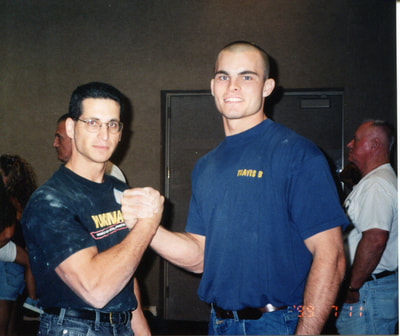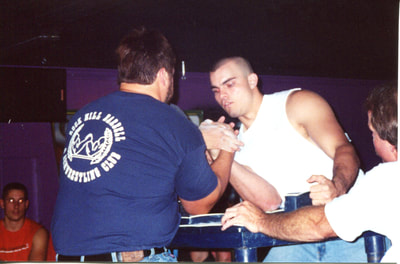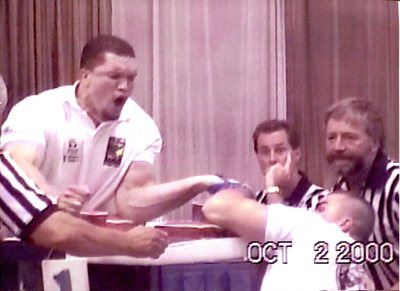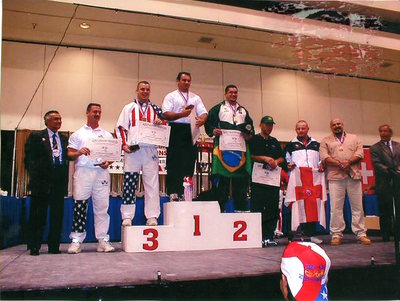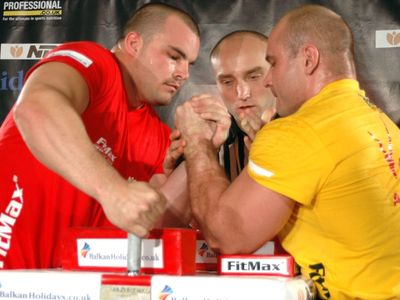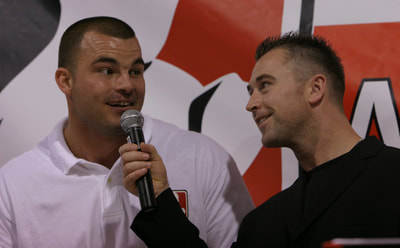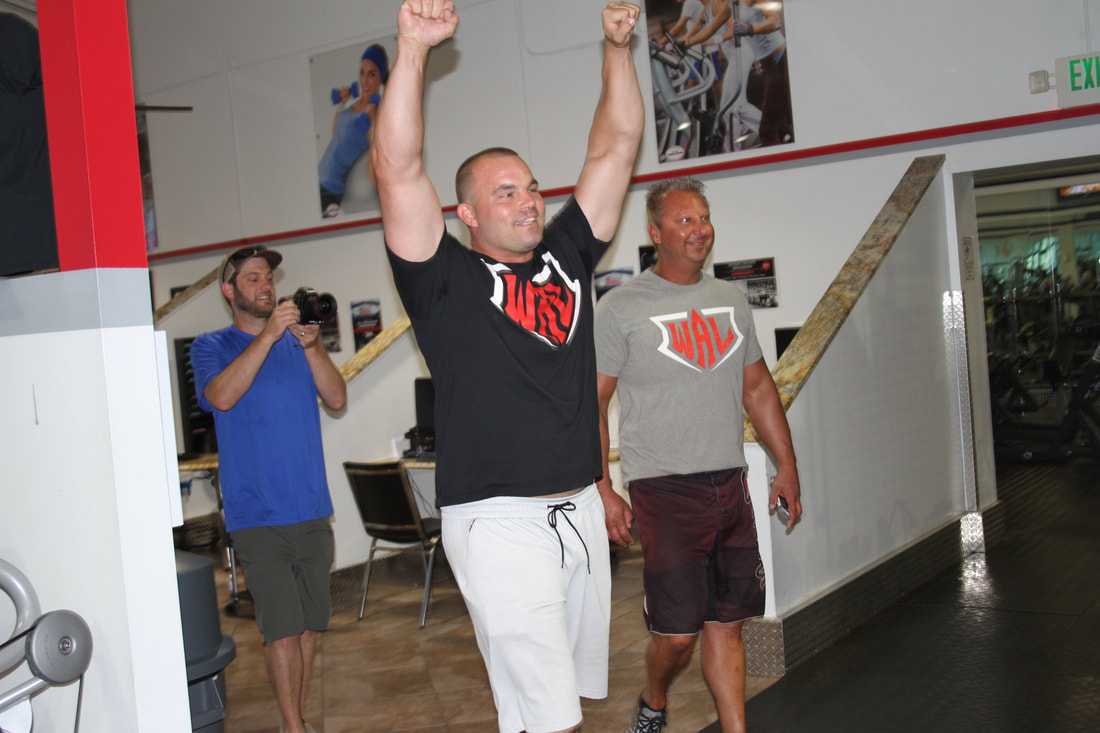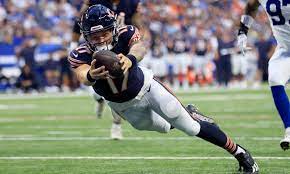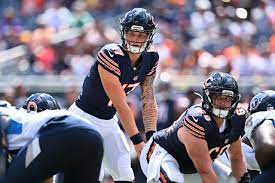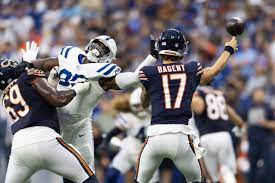WORLD CHAMPIONS OF THE PANHANDLE
Travis Bagent Wins 17th World Arm-wrestling Championship—and Puts the Sport on the Map
Travis “The Beast” Bagent showed his decisive victory and enduring strength in earning his 17th world arm-wrestling championship last night on ESPN. He is the only super heavyweight (males over 226 pounds) in the world to win the world championship with both his left and right arms. In the world of wrist-wrestling, most athletes compete with one arm, but the Mohammed Ali-esque Bagent can truly back up his taunts to competitors to “Tell me I’m the greatest,” because he actually is.
His first world title came in 2002, when he also won with both arms. He’s competed most years since, earning 11 titles left-handed and another six with the right. He’s also snagged approximately 35 national titles, competing in his first nationals at age 19.
Now 39, the 6’3”, 265-pound Bagent commands respect for not only his strength, but for putting the sport of arm-wrestling on a world stage. And he’s not quitting anytime soon.
How and when did you get your nickname The Beast?
I went to an arm-wrestling tournament in Warsaw, Poland in 2004. I had just signed with an arm-wrestling league, but found out we had to have a nickname so the Poland promoter for the league told me, “You’re a beast,” and it’s stuck ever since.
You’ve won so many titles at this point, are you currently the winningest arm-wrestler in the world?
I don’t know. There are some 55-year old dudes that have been pulling since they were young. Some guys can pull a few weight classes, especially back when the sport wasn’t big. So there are probably some guys with more wins. But there is no arm-wrestler in the world with as many left and right championships as me and no one who has won both the overall super heavyweight left and right championship. We have guys who have won their weight classes but not the overall. I was born lucky to be left-handed. Left-handed is really easy. More guys are righty. And 99 percent of human beings are substantially better with one arm. Rarely is their off-arm the better one.
I know you learned the sport from your father, Jerry Boyd, himself a national arm-wrestling champion, and he had the vision of what you’d become. Looking back, can you see how the pieces all fit together to bring you to where you are today?
There is no doubt that arm-wrestling is a super unnatural movement that requires tons of on-the-job experience. No two people are the same. Every time you grab someone’s hand, the length of their arm, their hand size, how they apply pressure, all the angles and leverage, it’s unique. You get used to the feeling of your training partners and that’s a negative. I had hundreds of different hands to grab as a young kid. My father owned two clubs — The Big Arm in Shepherdstown and later, Billy Jack’s in Charles Town — offering me hundreds of opportunities to arm-wrestle people who were stronger and different than me. I had a lot of time to work at it and having all that experience before I went to the national championships gave me an edge. Few people have a situation like mine, a place where there are 10 tables and 400 to 600 competitors every Friday, Saturday and Sunday. And I cared desperately about finding someone in there I could beat! I didn’t stop until I did, and one thing I had the ability to do was beat people who were stronger than me. I don’t think most people get that.
I know your father passed away earlier this year. What pearls of wisdom of his do you use most?
He passed about five minutes before the regional finals in May. He used to say, ‘You’re not gonna let this guy beat you just because he’s stronger than you?” and I think about that a lot. There are ways around that. I was trying to gain his love and respect anyway, but I wanted to win for him, too. In Pulling John[a documentary released in 2009], my dad says, “It’s only the beginning of what he’s going to achieve’ and ‘I know what I know what I know.’ Every time I go to the world championships, I listen to his recorded trigger phrases from the film to help me stay focused. This last time, it was very easy — almost like an out-of-body experience. There is no doubt in my mind the whole mental process of focusing and getting prepared makes a huge difference. I think this last match, because of his death and how I felt about our relationship, the regrets and what we could have done better, created a perfect storm. I am amazed at how efficient and easy it seemed to be to win.
That’s powerful.
I know, and I’m not a weirdo. I don’t believe in stuff I can’t touch or see. It was almost like someone else was in control. It was also scary, because I don’t know if I’ll be able to summon that all the time. I’m not necessarily stronger than I’ve been in the past or than my competitor, but I wanted it. A lot of people are taken aback by the post game show or the pre-game antics, but it seemed even the crowd was all behind Travis Bagent as well this time, which was kind of strange. You can talk a lot of trash, but when you start backing it up at a tremendous level, it’s no longer BS. There were a lot more fans than haters this year. The haters, in the past, have given me a lot of motivation. I accept that and am cool with that, so it was a little different, but maybe even more powerful.
To what do you attribute your success in the sport?
I think it was my exposure at a young age, how important it was to my family that we excel at it, and I think I’m a pretty amazing, bad dude. I have the ability, the size, the power, the speed and the intelligence to do some amazing stuff and come up with a plan. The only part I struggle with slightly is the day-to-day execution. I’m a little lazy.
The world championships used to be held in other countries. Then the World Armwrestling League (WAL) was created in 2013, holding championships here in North America. WAL is the largest and fastest growing professional arm-wrestling league in the world, but there is still the World Armwrestling Federation (WAF) going strong in Europe with numerous classes. Doesn’t WAL and WAF compete? How can there be one world champion with two governing bodies?
There will be situations where the world champ is not at a world competition but as soon as that world champ gets any press or media, it won’t be long before he has to defend it. Arm-wrestlers go to tournaments because that’s where they want to be. People miss events, but for the most part, everyone is always there. It’s kind of like golf or tennis, where there are hundreds of events a year but everyone knows there are four or five big ones and that’s where the most money and prestige are. Arm-wrestling is a brutal, unnatural sport and movement, so hurting yourself is pretty easy. Can you keep your world title is always the question.
How has the sport changed in your lifetime?
Arm-wrestling has become an actual industry. Every single weekend, I’m throwing arm-wrestling tournaments, working expos and/or running the event, on the mic refereeing, throwing seminars or arm-wrestling at a booth at a fitness event. For me, it’s now a $500,000 to $1 million career. It used to be a $25,000 annual situation — so, a good little part-time hobby — but I’m getting ready to sign with a big sponsor and there is a million dollars in endorsements because of winning the title in Las Vegas.
You’ve had some screen time, first in “Pulling John,” in 2003, and then the inaugural season of “Game of Arms,” in 2014. Did that exposure impact your life significantly?
Not significantly. I think the perception of these reality shows is that there’s going to be a lot of money to follow. Don’t get me wrong — it was a whole different fan base. Because of Game of Arms, there were a lot of women and young people who got exposed to arm-wrestling. There were times walking down the street was hilarious…with people honking horns and recognizing me and I loved it. But because those shows like to show drama and people not always in their best light, that can turn away a good sponsor.
Are other television shows in the works? Would you do another series?
I would consider anything but now with all the contracts, they have some say so it’s not as cut and dry as it used to be. Nowadays, I have to run it through agents and lawyers. I think I should have my own reality show. That show would still be going if it was just me.
You’ve often trained differently than other arm-wrestlers. What do you do differently to stay on top, and are you always tweaking your methods?
I’m never tweaking, but to me, it’s all about activity. You can talk about how much you train, but I don’t think the guys that are winning are super active every day all day. Whether it’s lifting, squeezing, moving correctly, arm-wrestling is on their minds, all the time. I was training hard to win, then my father passed away, then I kicked it up to a whole new ridiculous level. I’m not telling you I’m some stud that’s going balls to the wall for eight hours, but the plan is perfect. Tere are no wasted movements; everything I do is done with procedure in mind. The ref is going to square our shoulders and line us up, then we close our thumbs, close our hands and go, so all my training is structured to get ready for those movements.
Your favorite arm-wrestling technique is high side pressure. Can you explain the different methods and why this is your favorite? How many are there?
A lot of people use various terms but there are three: the hook, the press and the top roll. No matter how they pull, what absolutely destroys their technique is high side pressure. I’m going to guard my hand by being as high as I can. There is always a leverage point, so in arm-wrestling, the further away you are from a guy’s hand is to be higher than his hand. I’m constantly trying to get higher. The goal is to be prepared so that you have no fear and it’s just sideways. It takes balls because the other guys are strong.
You are known for your smack-talking and big personality and have sometimes come under fire because of it. Where does that come from and how does it serve you?
I think the big personality comes when you want to talk trash and get yourself hyped but you don’t want anyone to get mad. I need to have some communication not to get in his head, but to get in mine. The easiest way to get away with it is to add some comic relief, a necessary relief to get away with talking. And I’ve learned I’m pretty good at it. It affects the other person. There’s the guy who pretends he doesn’t hear it. That makes me feel like I’m not significant and that I’m a punk. I answer myself with what I think he’s feeling, which only motivates and excites me. Then there’s the guy who tries to talk back and I love that guy. It makes it fun. Now the cameras are on us. But I can banter, and my inner dialogue says, ‘You think you can talk shit to me?’ Then there’s the guy who gets mad, think I’m disrespectful and then tries to aggressively approach me. Which makes me think this guy thinks he can bully me, which gets me fired up. One of these three things will happen. It’s inevitable. And it doesn’t matter how they take it, because it’s for me. I put a significant amount of pressure on myself so I have no choice but to perform.
How long do you think you’ll compete in the sport?
I will be going to the world championships and nationals until maybe 90 years old. I don’t plan on stopping. I have this unique ability to shrug off losses pretty quickly so if things don’t work out the way I plan, it takes me about five minutes to pout, but then I get over it and get back to work.
What have you done to give back to the sport?
I’m giving my complete time, my brain, every ounce of business marketing, everything, to make arm-wrestling as big as I can so that being the best means something. There is a bit of selfishness in there, but I would do it without the money and prestige. It’s everything I do; it’s all I do.
For anyone interested in getting started in competitive arm-wrestling, what advice do you have?
Find some local guys to pull with and know there’s a long road ahead but the journey is the fun part. Winning WAL hammers and world champion medals is great, but those after-parties and after-weigh-in dinners with arm-wrestlers and their wives, and the stories about being stranded in Poland or wherever, is what you’re going to remember. Those trophies will collect dust in the corners, but the memories — the traveling, the cutting weight, the comaraderie, those are the enjoyable parts of the journey.
Are there any clubs or organizations in the panhandle where people can pursue the sport?
I arm-wrestle on Tuesday nights in Martinsburg (email [email protected] if interested in participating). There are also clubs in Baltimore and Northern Virginia, so less than an hour away are three, 20-person clubs where people can train.
TRAVIS BAGENT AT A GLANCE
Sport: Arm-wrestling
World championship titles: 17
Nickname: The Beast
Years active: 20
Hometown: Ranson
Current residence: Martinsburg
Age: 39
Family: Married to high school sweetheart, Casey Humphreys. They have four children: Tyson, 16; Ezra, 11; Diem, 8; and Valyn, 2
Filmography: Game of Arms (TV Series), 2014; The Lloyd of the Burpee (TV Series), 2014; Pulling John (Documentary), 2009;
Late Show with David Letterman, 2003
His first world title came in 2002, when he also won with both arms. He’s competed most years since, earning 11 titles left-handed and another six with the right. He’s also snagged approximately 35 national titles, competing in his first nationals at age 19.
Now 39, the 6’3”, 265-pound Bagent commands respect for not only his strength, but for putting the sport of arm-wrestling on a world stage. And he’s not quitting anytime soon.
How and when did you get your nickname The Beast?
I went to an arm-wrestling tournament in Warsaw, Poland in 2004. I had just signed with an arm-wrestling league, but found out we had to have a nickname so the Poland promoter for the league told me, “You’re a beast,” and it’s stuck ever since.
You’ve won so many titles at this point, are you currently the winningest arm-wrestler in the world?
I don’t know. There are some 55-year old dudes that have been pulling since they were young. Some guys can pull a few weight classes, especially back when the sport wasn’t big. So there are probably some guys with more wins. But there is no arm-wrestler in the world with as many left and right championships as me and no one who has won both the overall super heavyweight left and right championship. We have guys who have won their weight classes but not the overall. I was born lucky to be left-handed. Left-handed is really easy. More guys are righty. And 99 percent of human beings are substantially better with one arm. Rarely is their off-arm the better one.
I know you learned the sport from your father, Jerry Boyd, himself a national arm-wrestling champion, and he had the vision of what you’d become. Looking back, can you see how the pieces all fit together to bring you to where you are today?
There is no doubt that arm-wrestling is a super unnatural movement that requires tons of on-the-job experience. No two people are the same. Every time you grab someone’s hand, the length of their arm, their hand size, how they apply pressure, all the angles and leverage, it’s unique. You get used to the feeling of your training partners and that’s a negative. I had hundreds of different hands to grab as a young kid. My father owned two clubs — The Big Arm in Shepherdstown and later, Billy Jack’s in Charles Town — offering me hundreds of opportunities to arm-wrestle people who were stronger and different than me. I had a lot of time to work at it and having all that experience before I went to the national championships gave me an edge. Few people have a situation like mine, a place where there are 10 tables and 400 to 600 competitors every Friday, Saturday and Sunday. And I cared desperately about finding someone in there I could beat! I didn’t stop until I did, and one thing I had the ability to do was beat people who were stronger than me. I don’t think most people get that.
I know your father passed away earlier this year. What pearls of wisdom of his do you use most?
He passed about five minutes before the regional finals in May. He used to say, ‘You’re not gonna let this guy beat you just because he’s stronger than you?” and I think about that a lot. There are ways around that. I was trying to gain his love and respect anyway, but I wanted to win for him, too. In Pulling John[a documentary released in 2009], my dad says, “It’s only the beginning of what he’s going to achieve’ and ‘I know what I know what I know.’ Every time I go to the world championships, I listen to his recorded trigger phrases from the film to help me stay focused. This last time, it was very easy — almost like an out-of-body experience. There is no doubt in my mind the whole mental process of focusing and getting prepared makes a huge difference. I think this last match, because of his death and how I felt about our relationship, the regrets and what we could have done better, created a perfect storm. I am amazed at how efficient and easy it seemed to be to win.
That’s powerful.
I know, and I’m not a weirdo. I don’t believe in stuff I can’t touch or see. It was almost like someone else was in control. It was also scary, because I don’t know if I’ll be able to summon that all the time. I’m not necessarily stronger than I’ve been in the past or than my competitor, but I wanted it. A lot of people are taken aback by the post game show or the pre-game antics, but it seemed even the crowd was all behind Travis Bagent as well this time, which was kind of strange. You can talk a lot of trash, but when you start backing it up at a tremendous level, it’s no longer BS. There were a lot more fans than haters this year. The haters, in the past, have given me a lot of motivation. I accept that and am cool with that, so it was a little different, but maybe even more powerful.
To what do you attribute your success in the sport?
I think it was my exposure at a young age, how important it was to my family that we excel at it, and I think I’m a pretty amazing, bad dude. I have the ability, the size, the power, the speed and the intelligence to do some amazing stuff and come up with a plan. The only part I struggle with slightly is the day-to-day execution. I’m a little lazy.
The world championships used to be held in other countries. Then the World Armwrestling League (WAL) was created in 2013, holding championships here in North America. WAL is the largest and fastest growing professional arm-wrestling league in the world, but there is still the World Armwrestling Federation (WAF) going strong in Europe with numerous classes. Doesn’t WAL and WAF compete? How can there be one world champion with two governing bodies?
There will be situations where the world champ is not at a world competition but as soon as that world champ gets any press or media, it won’t be long before he has to defend it. Arm-wrestlers go to tournaments because that’s where they want to be. People miss events, but for the most part, everyone is always there. It’s kind of like golf or tennis, where there are hundreds of events a year but everyone knows there are four or five big ones and that’s where the most money and prestige are. Arm-wrestling is a brutal, unnatural sport and movement, so hurting yourself is pretty easy. Can you keep your world title is always the question.
How has the sport changed in your lifetime?
Arm-wrestling has become an actual industry. Every single weekend, I’m throwing arm-wrestling tournaments, working expos and/or running the event, on the mic refereeing, throwing seminars or arm-wrestling at a booth at a fitness event. For me, it’s now a $500,000 to $1 million career. It used to be a $25,000 annual situation — so, a good little part-time hobby — but I’m getting ready to sign with a big sponsor and there is a million dollars in endorsements because of winning the title in Las Vegas.
You’ve had some screen time, first in “Pulling John,” in 2003, and then the inaugural season of “Game of Arms,” in 2014. Did that exposure impact your life significantly?
Not significantly. I think the perception of these reality shows is that there’s going to be a lot of money to follow. Don’t get me wrong — it was a whole different fan base. Because of Game of Arms, there were a lot of women and young people who got exposed to arm-wrestling. There were times walking down the street was hilarious…with people honking horns and recognizing me and I loved it. But because those shows like to show drama and people not always in their best light, that can turn away a good sponsor.
Are other television shows in the works? Would you do another series?
I would consider anything but now with all the contracts, they have some say so it’s not as cut and dry as it used to be. Nowadays, I have to run it through agents and lawyers. I think I should have my own reality show. That show would still be going if it was just me.
You’ve often trained differently than other arm-wrestlers. What do you do differently to stay on top, and are you always tweaking your methods?
I’m never tweaking, but to me, it’s all about activity. You can talk about how much you train, but I don’t think the guys that are winning are super active every day all day. Whether it’s lifting, squeezing, moving correctly, arm-wrestling is on their minds, all the time. I was training hard to win, then my father passed away, then I kicked it up to a whole new ridiculous level. I’m not telling you I’m some stud that’s going balls to the wall for eight hours, but the plan is perfect. Tere are no wasted movements; everything I do is done with procedure in mind. The ref is going to square our shoulders and line us up, then we close our thumbs, close our hands and go, so all my training is structured to get ready for those movements.
Your favorite arm-wrestling technique is high side pressure. Can you explain the different methods and why this is your favorite? How many are there?
A lot of people use various terms but there are three: the hook, the press and the top roll. No matter how they pull, what absolutely destroys their technique is high side pressure. I’m going to guard my hand by being as high as I can. There is always a leverage point, so in arm-wrestling, the further away you are from a guy’s hand is to be higher than his hand. I’m constantly trying to get higher. The goal is to be prepared so that you have no fear and it’s just sideways. It takes balls because the other guys are strong.
You are known for your smack-talking and big personality and have sometimes come under fire because of it. Where does that come from and how does it serve you?
I think the big personality comes when you want to talk trash and get yourself hyped but you don’t want anyone to get mad. I need to have some communication not to get in his head, but to get in mine. The easiest way to get away with it is to add some comic relief, a necessary relief to get away with talking. And I’ve learned I’m pretty good at it. It affects the other person. There’s the guy who pretends he doesn’t hear it. That makes me feel like I’m not significant and that I’m a punk. I answer myself with what I think he’s feeling, which only motivates and excites me. Then there’s the guy who tries to talk back and I love that guy. It makes it fun. Now the cameras are on us. But I can banter, and my inner dialogue says, ‘You think you can talk shit to me?’ Then there’s the guy who gets mad, think I’m disrespectful and then tries to aggressively approach me. Which makes me think this guy thinks he can bully me, which gets me fired up. One of these three things will happen. It’s inevitable. And it doesn’t matter how they take it, because it’s for me. I put a significant amount of pressure on myself so I have no choice but to perform.
How long do you think you’ll compete in the sport?
I will be going to the world championships and nationals until maybe 90 years old. I don’t plan on stopping. I have this unique ability to shrug off losses pretty quickly so if things don’t work out the way I plan, it takes me about five minutes to pout, but then I get over it and get back to work.
What have you done to give back to the sport?
I’m giving my complete time, my brain, every ounce of business marketing, everything, to make arm-wrestling as big as I can so that being the best means something. There is a bit of selfishness in there, but I would do it without the money and prestige. It’s everything I do; it’s all I do.
For anyone interested in getting started in competitive arm-wrestling, what advice do you have?
Find some local guys to pull with and know there’s a long road ahead but the journey is the fun part. Winning WAL hammers and world champion medals is great, but those after-parties and after-weigh-in dinners with arm-wrestlers and their wives, and the stories about being stranded in Poland or wherever, is what you’re going to remember. Those trophies will collect dust in the corners, but the memories — the traveling, the cutting weight, the comaraderie, those are the enjoyable parts of the journey.
Are there any clubs or organizations in the panhandle where people can pursue the sport?
I arm-wrestle on Tuesday nights in Martinsburg (email [email protected] if interested in participating). There are also clubs in Baltimore and Northern Virginia, so less than an hour away are three, 20-person clubs where people can train.
TRAVIS BAGENT AT A GLANCE
Sport: Arm-wrestling
World championship titles: 17
Nickname: The Beast
Years active: 20
Hometown: Ranson
Current residence: Martinsburg
Age: 39
Family: Married to high school sweetheart, Casey Humphreys. They have four children: Tyson, 16; Ezra, 11; Diem, 8; and Valyn, 2
Filmography: Game of Arms (TV Series), 2014; The Lloyd of the Burpee (TV Series), 2014; Pulling John (Documentary), 2009;
Late Show with David Letterman, 2003
A 2005 article written for The Journal by Katherine Cobb
Like father, like son: Bagent is the arm-wrestling champion of the world
RANSON — Before you even walk into Billy Jack’s Bar and Grill, you’re alerted to entering the arm-wrestling capital of West Virginia. A sign proclaims, “the glory of all young men is their strength” and in the world of arm-wrestling, that may very well be true.
Once you’re inside, you can almost smell the adrenaline. This is the place where you’re going to find big guys, big arms and big matches at the six tables front and center.
Billy Jack’s is owned by former national arm-wrestling champion Jerry Boyd, the father of current world arm-wrestling champion Travis Bagent.
Bagent, 28 and a resident of Charles Town, earned his title earlier this year in Poland where he defeated Andrey Pushkar from the Ukraine right-handed after winning five out of six matches. Next, he defeated Russian competitor Alexey Voevoda left-handed after besting him five out of six.
Because titles are determined by a cumulative score of wins vs. losses over a certain period, Bagent and Voevoda are tied for the right-handed world title, technically, but Bagent holds the left-hand title solo and is the undisputed “best left in the world.”
Only the best compete for the world title—contenders must hold the current national or world championship to be eligible. Several countries participate, and in fact, arm-wrestling is revered in many other countries, where it’s heavily promoted, abundantly sponsored, and given more credence than in America.
Bagent, a popular former athlete for Jefferson High School and Shepherd College, is tall with plenty of muscle and confidence to go around. He caught the arm-wrestling bug early on, after hanging around his father’s local tavern and watching him and others “pull,” as it’s known in the sport. “By age 15, I was there as much as possible, every Thursday, Friday and Saturday night,” said Bagent. “I knew early on it was what I wanted to do.”
Bagent competed in his first nationals at age 19 after enduring several years of losses. Since then, he has been the national champion 15 times, the number one-ranked arm-wrestler for North America and the world champion twice. This is the first time he has been the world champion for both his right and left hands, a feat not many compete in, let alone perfect the way Bagent has.
“It’s rare that anyone can do both arms, because arm-wrestling right-handed is so predominant. I’m left-handed, so I have developed strength and skill in both arms,” he said. Most of his matches are over in a few seconds, and he’s already legendary in the arm-wrestling world for his speed and strength.
Besides the critical support and training he’s received from his experienced father, Bagent cited several reasons he’s so good at arm-wrestling “Obviously, I’m blessed with good genetics,” he said, gesturing at his own sheer size. “I’m big and strong. I also dissected it mentally and figured out some angles and leverage points so that even if someone is stronger than me, I can beat them,” he said.
And it’s clear he’s beaten plenty of men stronger than he just by watching the videotape of ESPN arm-wrestling highlights blaring from the big screen TV in Billy Jack’s. “Being strong isn’t everything...someone can be strong but that doesn’t mean they are a good arm-wrestler,” said Bagent.
Bagent added when he arm-wrestles, he always has a good start, is coordinated and has a certain amount of intuition about who he is competing against that all come together to help him win matches.
To stay in shape, he trains constantly. He lifts weights three days a week at Gold’s Gym, doing specific exercises, and then does a total body workout two other days. He also arm-wrestles locally and regionally to stay in shape and competes in the arena of recognized events like the Arnold Classic.
Bagent credits his father with being a “big promoter and pioneer for the sport” in West Virginia. Boyd, who arm-wrestled under the name “Big Arm” and is still known by it today, has an impressive past in the sport. He was a world champion arm-wrestler for 23 years, winning over 417 titles. He learned how to arm-wrestle at age 19 while serving in the Marine Corps. In 1966, when he was 23, he brought the sport to West Virginia when he opened his first club in Ranson. Since then, he has earned the reputation for training some of the best arm wrestlers in America and having a school recognized around the world.
Boyd said, “Anyone can do it [arm-wrestle], even the weakest men and women. And it’s best to start them while they are young. My grandson Tyson, who is four, is already in training, making him the fifth generation in our family to arm-wrestle.” He added, “When he’s here, I make him arm-wrestle Granddad before he leaves every time.”
“Travis and I started at 16 and we didn’t do very well because we had 30-year-olds who had trained longer and were tournament sharp. After three years, Travis started winning. But you have to take a lot of punishment and losses before that happens. If you can endure that and follow our instructions, you can become a champion. Travis probably lost a thousand times before he won,” said Boyd. Then he summarized with one of his favorite sayings: “Before you’re a hero, you’re a zero.”
“No place in America teaches the skill of arm-wrestling the way we do. That’s why Travis is the undisputed world champion,” he said. Boyd has trained other world champions besides his son but admitted that “Travis is probably the best in the last five generations.”
Although more men than women are drawn to the sport, Boyd also trains several women “of great credibility” who “look just like the bank teller down the street, only they’re strong.” They are at different levels of training and competition with one woman having earned seven or eight titles already.
Billy Jack’s also hosts special challenge matches where the “best of the best” travel to the local Ranson club to compete. At least 40 world-class male and female arm wrestlers will accept the challenge, and Boyd said he expected one to take place later this year.
About Travis’ success, Boyd is every bit the proud father. “At 14 years old, I thought he would probably be good. At 17, I could tell he was going to be special. I could see he was going to be at the level he is now,” he said. “Travis is two-dimensional, as I was in my time, meaning we are left-handed and can compete with both arms. But it’s no accident Travis is the world champion. It was planned and now he’s simply following the plan and fulfilling it.”
“He is my hero now when I used to be his hero,” Boyd said.
Bagent will return to Poland on May 15, 2005, to defend his title. Prior to that, he’ll compete against Canada’s left-handed champion in Ashawa on March 26. He will also compete in the “Ultimate Arm-wrestling II, Pull at the Plaza,” in Las Vegas, Nev., on April 16, which is being filmed by Fox Sports Network.
Bagent is currently being featured in a documentary about arm-wrestling titled “Pulling John” (see www.pullingjohn.com) and his recent matches can also be viewed online at www.armwrestling.tv and www.armpower.net.
